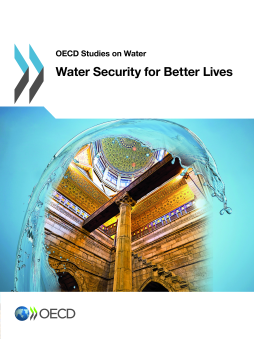
BOOK
Water Security for Better Lives
(2014)
Additional Information
Book Details
Abstract
This publication examines the critical issues surrounding water security (water shortage, water excess, inadequate water quality, the resilience of freshwater systems), providing a rationale for a risk-based approach and the management of trade-offs between water and other (sectoral and environmental) policies.
The report sets out a three-step process to "know", "target" and "manage" water risks: (1) appraising the risks, (2) judging the tolerability and acceptability of risks and weighing risk-risk trade-offs, and (3) calibrating appropriate responses.
The publication provides policy analysis and guidance on the use of market-based instruments and the complex links between water security and other policy objectives, such as food security, energy security, climate mitigation and biodiversity protection.
Table of Contents
| Section Title | Page | Action | Price |
|---|---|---|---|
| Cover\r | Cover | ||
| Table of contents | 5 | ||
| Acknowledgements | 8 | ||
| Abbreviations | 9 | ||
| Executive summary | 11 | ||
| Chapter 1:\rWhy does water security matter? | 13 | ||
| The water outlook | 15 | ||
| Applying a risk-based approach to water security: A conceptual framework | 16 | ||
| Know the risks | 19 | ||
| Target the risks | 21 | ||
| Manage the risks | 24 | ||
| Implementing the risk-based approach | 26 | ||
| What are the costs and impacts of inaction? | 27 | ||
| Notes | 28 | ||
| References | 28 | ||
| Chapter 2:\rApplying a risk-based approachto water security | 29 | ||
| Applying the “know”, “target” and “manage” framework | 30 | ||
| Know the risks | 30 | ||
| Target the risks | 33 | ||
| Manage the risks | 37 | ||
| Going beyond conventional approaches to address water security | 47 | ||
| Country cases | 48 | ||
| Managing risks of water shortage | 48 | ||
| Dealing with inadequate water quality | 57 | ||
| Managing flood risks | 58 | ||
| Securing resilience of groundwater systems | 59 | ||
| Applying a water risk strategy with a basin approach | 59 | ||
| Notes | 62 | ||
| References | 63 | ||
| Chapter 3:\rAchieving water security targetsthrough market-based instruments | 65 | ||
| Economic principles and instruments | 66 | ||
| Water supply | 68 | ||
| Water demand | 74 | ||
| Water quantity | 83 | ||
| Water quality | 87 | ||
| Integrated water resource management | 94 | ||
| Conclusions | 96 | ||
| Notes | 97 | ||
| References | 98 | ||
| Chapter 4:\rPolicy coherence toward water security | 105 | ||
| Spillover effects of sectoral and environmental policies on water security | 107 | ||
| Effects of non-water environmental markets on water security: Some empirical evidence | 112 | ||
| A framework for managing trade-offs between policies | 114 | ||
| Conclusions | 115 | ||
| Notes | 117 | ||
| References | 117 | ||
| ANNEXES | 119 | ||
| Annex A:\rGlossary of terms* | 121 | ||
| Notes | 123 | ||
| ANNEX B:\rBasic water facts | 125 | ||
| Water supply | 125 | ||
| Water demand | 129 | ||
| Water quantity | 133 | ||
| Water quality | 134 | ||
| Projections to 2050 | 135 | ||
| Potential impacts of climate change | 136 | ||
| Measuring water stress | 136 | ||
| Notes | 141 | ||
| References | 142 | ||
| ANNEX C:\rCosts and distributional impacts of inaction | 145 | ||
| Overview | 145 | ||
| Water of inadequate quality | 147 | ||
| Groundwater shortage | 159 | ||
| Notes | 167 | ||
| References | 168 | ||
| ORGANISATION FOR ECONOMIC CO-OPERATION\rAND DEVELOPMENT | 171 |
